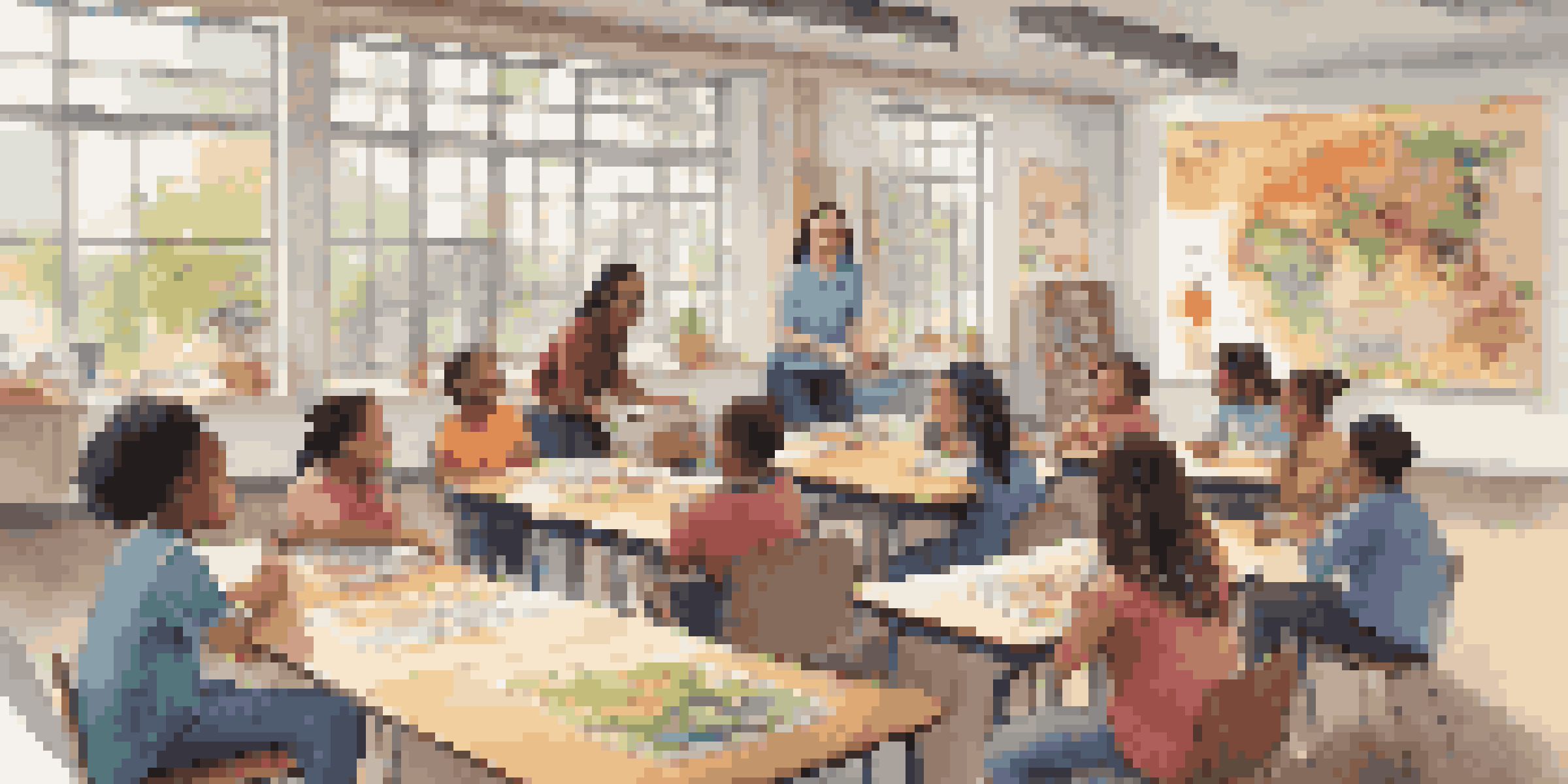Culturally Responsive Teaching: The Role of Reflection in Practice

Understanding Culturally Responsive Teaching Principles
Culturally responsive teaching (CRT) is an educational approach that recognizes and respects students' cultural backgrounds. It encourages educators to create inclusive classrooms where diverse perspectives are valued. By understanding and incorporating students' cultural experiences, teachers can foster a more engaging learning environment.
Teaching is the greatest act of optimism.
At its core, CRT promotes a connection between the curriculum and students' lives, making learning more relevant and meaningful. For instance, when a teacher relates a math lesson to local community issues, students can see the practical application of their skills. This relevance not only enhances motivation but also builds a sense of belonging.
Moreover, adopting CRT principles requires continuous learning and adaptation from educators. It’s not just about implementing strategies; it's about embracing an ongoing journey of understanding the rich tapestry of cultures represented in the classroom.
The Importance of Reflection in Education
Reflection is a critical component in the teaching process, serving as a tool for both personal and professional growth. It allows educators to assess their practices, identify areas for improvement, and celebrate successes. This self-awareness can significantly enhance teaching effectiveness.

When teachers reflect on their experiences, they can better understand their biases and assumptions, which is essential for implementing CRT. For example, a teacher who regularly reflects on their interactions with students may notice patterns that require adjustment to better engage all learners. This conscious effort leads to more equitable practices in the classroom.
Culturally Responsive Teaching Matters
Culturally responsive teaching fosters inclusive classrooms by valuing diverse cultural backgrounds and making learning relevant to students' lives.
Ultimately, reflection fosters a culture of continuous improvement. By taking the time to evaluate what works and what doesn’t, teachers can evolve their instructional methods, ensuring that they are meeting the diverse needs of their students.
Strategies for Effective Reflection
To truly benefit from reflection, educators need structured strategies to guide their thinking. One effective method is keeping a reflective journal, where teachers can jot down their thoughts and insights after lessons. This practice not only helps in documenting progress but also encourages deeper analysis of classroom dynamics.
We cannot become what we need to be by remaining what we are.
Another approach is engaging in collaborative reflection with peers. By discussing experiences and sharing feedback, teachers can gain new perspectives that might not have been considered alone. This collaborative effort can inspire innovative teaching strategies that are culturally responsive.
Additionally, dedicating time for regular reflection—whether through professional development sessions or informal discussions—can create a supportive environment for growth. The key is to make reflection a consistent part of the teaching routine, rather than an afterthought.
Connecting Reflection to Student Outcomes
The ultimate goal of culturally responsive teaching and reflection is to enhance student learning outcomes. When educators reflect on their practices, they can tailor their approaches to better meet the needs of their diverse student population. This adaptability leads to improved engagement and academic success.
For instance, a teacher who reflects on their lesson plans might realize that certain cultural references resonate more with students, prompting them to adjust future lessons. Such changes can help students feel more connected to the material, ultimately leading to a deeper understanding of the subject matter.
Reflection Enhances Teaching Practices
Regular reflection enables educators to assess their teaching methods, identify biases, and adapt practices to meet diverse student needs.
Moreover, when students see their cultures represented in the curriculum, they are more likely to participate actively. This connection not only boosts their confidence but also contributes to a more dynamic and interactive classroom environment.
Challenges in Implementing Reflection
While reflection is invaluable, implementing it effectively can be challenging for educators. Time constraints often hinder the ability to engage in meaningful reflection, especially in busy school environments. Teachers may feel overwhelmed by their responsibilities, leaving little room for introspection.
Additionally, some educators may struggle with vulnerability, fearing judgment when sharing their reflective thoughts with colleagues. This reluctance can stifle honest conversations that are crucial for growth and learning. Creating a safe space for sharing reflections is essential to overcoming this barrier.
Lastly, without a clear framework for reflection, teachers may find themselves unsure of what to focus on. Providing guidance and resources can help educators structure their reflection process, making it more manageable and effective.
Promoting a Reflective Culture in Schools
To foster a culture of reflection in schools, leadership plays a vital role. Administering professional development that emphasizes the value of reflective practices can inspire educators to prioritize this essential component of teaching. When school leaders model reflective behavior, it sets a tone for the entire faculty.
Creating collaborative opportunities for teachers to share and discuss their reflections can also enhance this culture. Regular meetings or workshops that focus on experiences and insights can facilitate growth and support. This collective approach strengthens community and encourages shared learning.
Leadership Cultivates Reflective Culture
School leadership is essential in promoting a culture of reflection through professional development, collaboration, and recognition of educators' reflective practices.
Furthermore, recognizing and celebrating the reflective practices of educators can motivate others to engage in similar activities. By highlighting success stories and the impact of reflection on student learning, schools can cultivate an environment where reflection is not just encouraged, but celebrated.
The Future of Culturally Responsive Teaching
As education continues to evolve, the importance of culturally responsive teaching and reflection cannot be overstated. With an increasingly diverse student population, educators must be equipped to meet varying cultural needs effectively. The future of education relies on recognizing and embracing these differences.
Moreover, technology can play a significant role in supporting reflection and culturally responsive practices. Online platforms can provide resources, forums, and tools that facilitate collaborative reflection among educators. This access can empower teachers to share insights and strategies, further enriching their practice.

In essence, the journey towards culturally responsive teaching is ongoing, and reflection is at its heart. By committing to this process, educators can create inclusive classrooms that celebrate diversity and promote equitable learning opportunities for all students.